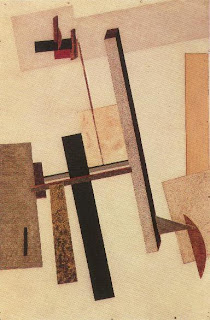









El Lissitzky was born in 1890.
Russian painter, typographer, and designer, a pioneer of nonrepresentational art in the early 20th century. His innovations in typography, advertising, and exhibition design were particularly influential.



Lissitzky studied architecture at Darmstadt, Ger., and, during WW1, at Moscow. In 1919 Marc Chagall appointed him teacher at the revolutionary school of art in Vitebsk. Kasimir Malevich, the painter and founder of the Suprematist movement, which advocated the supremacy of pure geometric form over representation, also taught there, and he greatly influenced Lissitzky. In 1919 Lissitzky began to work on a series of abstract geometric paintings that he named “Proun,” an acronym for the Russian words translated as “Projects for the Affirmation of the New.” These paintings were a major contribution to the Constructivist art movement. In 1921 he became professor at the state art school in Moscow. He founded the international journal 'Vesc' in 1922 and devoted himself increasingly to typography and exhibition design. In Germany, he met the artist-designer Lászlo Moholy-Nagy, who transmitted Lissitzky’s ideas on art to western Europe and the United States through his teaching at the Bauhaus.


In 1925 Lissitzky returned to Moscow and taught at the post-Revolutionary art school Vkhutemas. Between 1926 and 1934 Lissitzky designed several exhibitions. Lissitzky worked on the journal 'The USSR in Architecture', for which Lissitzky and his wife, Sophie Lissitzky-Küppers, designed a great many issues. Lissitzky was a Russian avant-garde artist who did not limit himself to developing a form of abstract painting but rather extended the new functionalism to photography, book design, architecture and urban planning. His enormous versatility enabled El Lissitzky to forge links between the Russian Constructivists and Neo-Plasticism (De Stijl), the Bauhaus and Dada.


His experiments in spatial construction led him to devise new techniques in exhibiting, printing, photomontage, and architecture, which have had much influence in western Europe.


No comments:
Post a Comment